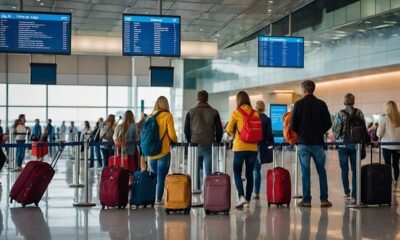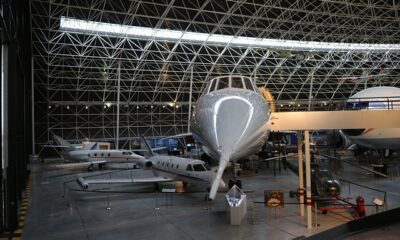Aviation
Boeing, Singapore Airlines Announce Order for 39 Airplanes

WASHINGTON, Oct. 23, 2017 /PRNewswire/ — Boeing [NYSE: BA] and Singapore Airlines (SIA) today formally announced a deal for 20 777-9s and 19 787-10s, during a ceremony at the White House.
The order, previously attributed to an unidentified customer, is worth $13.8 billion at current list prices. The value of this sales transaction will sustain thousands of U.S. suppliers and more than 70,000 direct and indirect U.S. jobs during the delivery period of this contract. The airline also has options for 12 additional aircraft, six of each aircraft type.
The signing ceremony, witnessed by US President Donald Trump and Prime Minister of Singapore Lee Hsien Loong, included Singapore Airlines’ CEO Goh Choon Phong and Boeing Commercial Airplanes’ President & CEO Kevin McAllister. Peter Seah, Singapore Airlines’ Chairman, and Dinesh Keskar, senior vice president, Asia Pacific & India Sales, Boeing Commercial Airplanes and other members of the airline and Boeing also were in attendance.
“SIA has been a Boeing customer for many decades and we are pleased to have finalised this major order for widebody aircraft, which will enable us to continue operating a modern and fuel-efficient fleet,” said Goh. “These new aircraft will also provide the SIA Group with new growth opportunities, allowing us to expand our network and offer even more travel options for our customers.”
Singapore Airlines has more than 50 777s in service and is the launch customer of the 787-10, which is set to deliver in the first half of 2018. With a prior order for 30 787-10s, the airline now has 49 on order, making it the largest customer for this type. A long-range airplane that’s efficient at any stage length, the 787-10 will serve the airline’s medium-range operations while partnering with the 777-9 for the carrier’s long-haul routes. Its subsidiaries SilkAir, Scoot and SIA Cargo also operate Boeing airplanes with the 737 MAX 8 and 737-800, 787-8 and 787-9 Dreamliners and 747-400 Freighter types in service, respectively.
“Boeing and Singapore Airlines have been strong partners since the airline’s first operations 70 years ago and we are thrilled to finalise their purchase of 20 777Xs and 19 additional 787-10 Dreamliners,” said McAllister. “Singapore Airlines’ order is a testament to the market-leading capabilities of Boeing’s widebody airplanes and we look forward to delivering the very first 787-10 to them next year.”
With more than 1,280 orders from 70 customers worldwide, the 787 Dreamliner family offers three modern and efficient airplanes that are optimized for markets ranging from 200 seats to over 350 seats. To date, more than 600 787s have entered commercial service. They have flown nearly 200 million people on more than 560 unique routes – including 156 new nonstop routes – while saving an estimated 19 billion pounds of fuel.
The 787-10, the largest family member, adds seats and cargo capacity while offering 25 percent better fuel efficiency per seat and lower emissions than the airplanes it will replace. The combination of capability, reliability and efficiency has attracted carriers from around the world, including Asia where the 787-10 will be able to connect all points within Asia at lower seat costs than any other twin-aisle airplane, with the flexibility to also link to Europe, Africa and Oceania.
The 777X, builds on the passenger-preferred and market-leading 777, and will be the largest and most-efficient twin-engine jet in the world, with the latest innovative technologies, including the most advanced, fuel-efficient commercial engine ever. Opening new growth opportunities for airlines, the 777-9 will have the lowest operating cost per seat of any commercial airplane. The 777-9 seats 400-425 passengers with a range of 7,600 nautical miles (14,075 km) and is the only twin-engine available of its size.

Aviation
Exploring the Different Types of Helicopter Rotor Systems and the Science Behind Them

Helicopters are unique aircraft that use rotating blades, called rotors, to generate lift and enable flight. The design of these rotor systems is crucial because it affects how helicopters perform, maneuver, and respond to different flying conditions.
There are several types of helicopter rotor systems, each with its own advantages and specific uses. Understanding these systems helps us appreciate the engineering behind helicopters and their diverse capabilities, from search and rescue missions to military operations and aerial photography.
In this Video, we will explore the main types of helicopter rotor systems and how they contribute to the helicopter’s functionality and performance.
1. Single Rotor System
The single rotor system is characterized by a single main rotor blade that is responsible for generating lift. To counteract the torque produced by this rotor, a tail rotor is used. This setup is essential for maintaining directional control and stability during flight.
Uses: This design is prevalent in most conventional helicopters, including iconic models such as the Bell 206 and the Robinson R22. The simplicity of the single rotor system not only reduces mechanical complexity but also enhances efficiency. As a result, it is favored for a variety of applications, including aerial tours, law enforcement, and emergency medical services, where reliability and straightforward operation are paramount.
2. Tandem Rotor System
The tandem rotor system features two parallel rotors of equal size that rotate in opposite directions. This counter-rotation helps to cancel out the torque that each rotor would otherwise produce, resulting in a balanced and stable flight profile.
Uses: This configuration is typically employed in heavy-lift helicopters, such as the CH-47 Chinook. The tandem design allows for an increased payload capacity and enhanced stability, making it particularly effective for transporting troops, equipment, and supplies in military operations, as well as for civilian applications like logging and construction, where heavy lifting is required.
3. Coaxial Rotor System
The coaxial rotor system consists of two rotors mounted one above the other on the same mast, rotating in opposite directions. This innovative design minimizes the need for a tail rotor, allowing for a more compact helicopter structure.
Uses: Coaxial rotor systems can be found in helicopters such as the Kamov Ka-50. This design offers several advantages, including enhanced lift capabilities, improved maneuverability, and better control in various flight conditions. These features make it particularly suitable for military applications, where agility and quick response times are crucial, as well as for specific civilian operations that require high performance in tight spaces.
4. Intermeshing Rotor System
The intermeshing rotor system consists of two rotors that rotate in opposite directions while intersecting each other, but without colliding. This unique configuration creates a highly efficient aerodynamic profile.
Uses: This system is utilized in helicopters like the Kaman K-MAX, designed specifically for heavy lifting and aerial work. The intermeshing rotors provide remarkable stability and lift capabilities, making it particularly effective for operations in confined spaces, such as urban environments or dense forests. It is ideal for missions that involve heavy external loads, including construction, firefighting, and disaster relief efforts.
5. Transverse rotor system
The transverse rotor system has two parallel rotors that spin in opposite directions, improving lift and stability. This design enhances the aircraft’s aerodynamic efficiency and maneuverability.
A notable example of this system is the V-22 Osprey, a tiltrotor aircraft that merges helicopter vertical lift with the speed of a fixed-wing plane. allowing the Osprey to operate in tough environments like urban areas and remote locations. It can carry heavy loads and personnel, making it suitable for troop transport, search and rescue, medical evacuation, and logistical support in military operations. Overall, the transverse rotor system enhances the V-22 Osprey’s effectiveness and operational flexibility.
6. Compound Rotor System
The compound rotor system combines traditional rotor systems with fixed wings and other aerodynamic features to enhance efficiency and speed. This hybrid approach allows for greater aerodynamic performance than standard rotorcraft.
Uses: Advanced helicopters like the Sikorsky X2 and Boeing’s DBF (Defiant) utilize the compound rotor system. These helicopters are designed for higher speeds and longer ranges, making them suitable for military operations, search-and-rescue missions, and law enforcement tasks where rapid response and extended operational capabilities are essential.
7. NOTAR system
NOTAR system replaces the traditional tail rotor with a ducted fan and directional airflow to counter the torque from the main rotor. It works by pushing air through the tail boom and out through side vents, creating thrust that stabilizes the helicopter. This design reduces noise, boosts safety, and cuts down on maintenance.
Uses: The NOTAR system is found in helicopters like the MD 520N and MD 902 Explorer. Without an exposed tail rotor, it lowers the risk of rotor strikes, making it safer for operations in tight spaces. Its quieter performance is ideal for missions where low noise is needed, such as urban air operations, police work, and medical evacuations.
-

 Aviation2 months ago
Aviation2 months agoNew EU Carry-On Rules Begin September 2024: What to Expect
-

 Aviation2 months ago
Aviation2 months agoBoeing confirms 797: A New Era for Mid-Size Aircraft
-

 Aviation2 months ago
Aviation2 months agoLockheed and Tata Team Up to Build C-130J MRO Facility in India
-

 Aviation1 month ago
Aviation1 month agoMicrosoft Flight Simulator Raises $3 Million to Bring Back the An-225 Mriya
-

 Tech2 months ago
Tech2 months agoChina Developing Jet to Travel Anywhere in Two Hours
-

 Airlines2 months ago
Airlines2 months agoQantas Engineers Stage Walkout Over Cost of Living Concerns
-

 Aviation2 months ago
Aviation2 months agoBoeing Offers 25% Pay Increase & Promise to Build Next Plane in Seattle
-

 Airlines1 month ago
Airlines1 month agoQatar Citizens Can Travel to the United States Without a Visa








